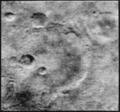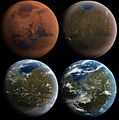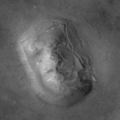Mars in fiction facts for kids
Stories about the planet Mars have been popular for over 100 years! Mars is often called the "Red Planet" because of its color. It's also quite close to Earth and looks a bit like our home planet. Many tales imagine what life on Mars might be like. Some even feature creatures from Mars visiting Earth.
In the late 1800s, an astronomer named Giovanni Schiaparelli saw what he thought were channels on Mars. He called them canali, which means "channels" in Italian. But when people translated this, they often used the word "canals." This made many think intelligent beings built them! This idea led to many exciting stories about Martians.
This article explores famous books and stories about Mars. It looks at how authors imagined the planet and its civilizations.
Contents
Exploring Mars: Early Stories
Early science fiction often focused on the first trips to Mars. Sometimes, these trips were invasions. More often, they were for exciting exploration.
First Journeys to the Red Planet
Many early writers imagined contact with Mars. These stories often involved humans traveling to the planet. They explored what they might find there.
- Across the Zodiac (1880) by Percy Greg
- The War of the Worlds (1898) by H. G. Wells. This famous book tells of Martians invading Earth. It was later made into a radio show and movies.
- Edison's Conquest of Mars (1898) by Garrett P. Serviss.
- A Princess of Mars (1912) by Edgar Rice Burroughs. This was the first of many popular Mars stories by Burroughs.
- Aelita (1922) by A.N. Tolstoy.
- Les Navigateurs de l'Infini (1925) by J.-H. Rosny aîné. In this story, humans travel to Mars and meet two different alien races.
- Out of the Silent Planet (1938) by C. S. Lewis.
Life on Mars: A New Setting
By the 1930s, stories about simply reaching Mars became less exciting. Authors started to focus on Mars as a strange, alien world. In these tales, humans had already visited the planet. Mars became a setting for adventures, not just a goal.
- The Northwest Smith stories (1933–1936) by C. L. Moore.
- The Secret of Sinharat (1940) by Leigh Brackett. She wrote many stories set on Mars.
- Red Planet (1949) by Robert A. Heinlein.
- The Martian Chronicles (1950) by Ray Bradbury. This is a collection of stories about humans settling on Mars.
- The Sands of Mars (1951) by Arthur C. Clarke.
- The Martian Way (1952) by Isaac Asimov.
- The Sirens of Titan (1959) by Kurt Vonnegut.
- Martian Time Slip (1964) by Philip K. Dick.
Mars in the Modern Age
Starting in 1965, space probes like Mariner and Viking visited Mars. They showed that the "canals" were just an illusion. They also revealed that Mars is a very harsh place for life. By the 1970s, the idea of ancient Martian civilizations faded.
Authors then began writing stories based on this new, realistic Mars. It was often shown as a desert planet. Many stories featured humans trying to make the planet livable. This process is called terraforming. It means changing a planet's environment to be more like Earth's.
Mars Colonies and Independence
A common idea in modern Mars stories is a human colony fighting for freedom from Earth. This theme appeared in Heinlein's Red Planet. It's also a big part of Kim Stanley Robinson's Mars trilogy. You can see it in movies like Total Recall and TV shows like Babylon 5. Many video games, such as Red Faction, use this idea too.
New Expeditions to Mars
After the space probes, realistic stories about first trips to Mars became less common. But in the 1990s, new novels about Mars expeditions appeared. These books imagined large-scale missions to the planet.
- Mars (1992) by Ben Bova.
- The Martian Race (1999) by Gregory Benford.
- Mars Crossing (2000) by Geoffrey A. Landis.
- First Landing (2002) by Robert Zubrin.
Later Stories and Themes
- Man Plus (1976) by Frederik Pohl. An astronaut is changed into a cyborg to live on Mars.
- Watchmen (1985) by Alan Moore and Dave Gibbons. This comic features a character named Dr. Manhattan who visits Mars.
- Kim Stanley Robinson's Mars trilogy (Red Mars, Green Mars, Blue Mars, 1992–1996). This series explores the long process of terraforming Mars.
- Moving Mars (1993) by Greg Bear.
- Voyage (1996) by Stephen Baxter.
- The Quantum Thief (2010) by Hannu Rajaniemi.
- The Martian (2011) by Andy Weir. This book tells the story of an astronaut stranded on Mars. It was also made into a popular movie.
Nostalgic Mars: Old Ideas Reimagined
Some newer stories look back at the older ideas of Mars. They might imagine a future where Mars has been terraformed. Or they create alternate history versions of Mars. In these, the old tales of canals and Martians are real!
- Philip José Farmer's World of Tiers series (1965–1993).
- Rainbow Mars (1999) by Larry Niven.
- "Larklight" (2006) by Phillip Reeve.
Mars in Comics
Mars and Martians are very popular in comic books!
- In the Watchmen comic, Dr. Manhattan visits Olympus Mons on Mars. He admires its features.
- The 2000 AD series The V.C.s shows Olympus Mons' crater covered by a huge dome. This dome holds an atmosphere for the main settlement on Mars.
- The DC Comics character Martian Manhunter is from Mars. Most Green Martians were wiped out by a plague. Martians are very powerful, with telepathy, shapeshifting, and flight.
- In Wonder Woman Pre-Crisis comics, Mars was the home of the god Mars (also known as Ares).
- In the Manga and Anime Sailor Moon (1992), the character Rei Hino is a modern descendant of the god Ares. She is Sailor Mars, and her attacks use fire.
- In the comic strip Calvin and Hobbes, Calvin and Hobbes travel to Mars. They do this because Earth is too polluted.
Martians in Fiction
The Martian is a classic character in science fiction. Often, they are found away from their home planet. Sometimes they invade Earth. Other times, they are lonely characters, showing how different aliens can be. After the space probes showed Mars was lifeless, Martians became rare in new fiction. But they still appear in comics and animation, often as a nod to older stories.
Images for kids
-
H. G. Wells' The War of the Worlds is one of the most influential works of science fiction.
-
Data returned from Mars exploration missions in the 1960s and 1970s, such as this photograph by the Mariner 4 probe, led to stories of life on Mars becoming unfashionable.
-
Some works depict Mars being terraformed to allow human habitation.
-
The purported Martian canals (map by Percival Lowell)








